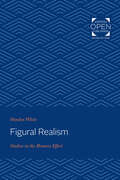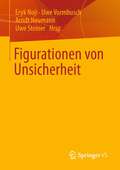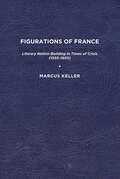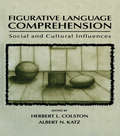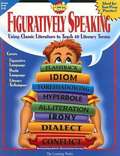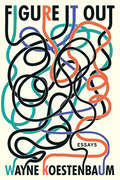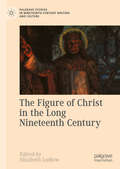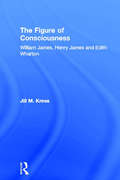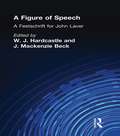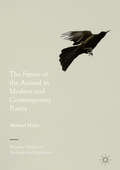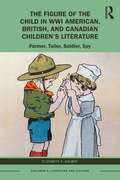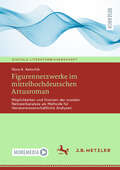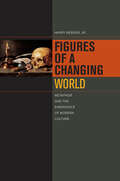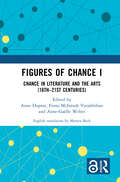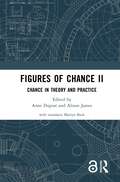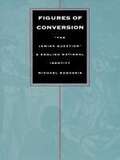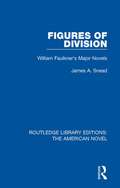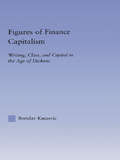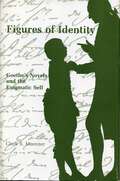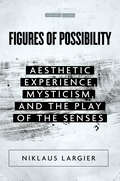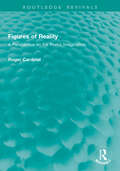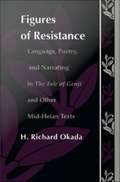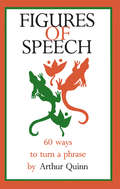- Table View
- List View
Figural Realism: Studies in the Mimesis Effect
by Hayden WhiteOriginally published in 1998. In his earlier books such as Tropics of Discourse and The Content of the Form, Hayden White focused on the conventions of historical writing and on the ordering of historical consciousness. In Figural Realism, White collects eight interrelated essays primarily concerned with the treatment of history in recent literary critical discourse. "'History' is not only an object we can study," writes White, "it is also and even primarily a certain kind of relationship to 'the past' mediated by a distinctive kind of written discourse. It is because historical discourse is actualized in its culturally significant form as a specific kind of writing that we may consider the relevance of literary theory to both the theory and the practice of historiography."
Figurationen von Unsicherheit
by Eryk Noji Uwe Vormbusch Arndt Neumann Uwe SteinerJede Zeit, jede Gesellschaft kennt ihre eigenen Figurationen von Unsicherheit. Der Band fragt nach den historisch variablen Strategien, Mechanismen und Kulturtechniken, mittels derer Gesellschaften Unsicherheiten thematisieren und bearbeiten. Solche Praktiken sind keineswegs durchgängig auf Unsicherheitsvermeidung bzw. -absorption ausgerichtet. Vielmehr existieren Strategien der Erzeugung und der Absorption von Unsicherheit parallel und verweisen aufeinander. Dieser Diagnose versuchen die interdisziplinären Perspektiven, die dieser Band versammelt, Rechenschaft zu tragen. Geschichtswissenschaften, Literatur- und Medienwissenschaften, Philosophie, Psychologie, Soziologie – sie alle haben eigene Zugänge zum Phänomen der Unsicherheit. Dies zeigt sich auch in der Bandbreite der hier verhandelten Themen: das Entscheiden und Nicht-Entscheiden, Algorithmen und Prognosen, Prävention und Fiktion, Erfahrungsgeschichte, Emotionen und politische Repräsentation, Self-Tracking, Bewertung und Lernen.
Figurations of France: Literary Nation-Building in Times of Crisis (1550-1650)
by Marcus KellerIn Figurations of France: Literary Nation-Building in Times of Crisis (1550-1650), Marcus Keller explores the often indirect and subtle ways in which key texts of early modern French literature, from Joachim Du Bellay’s Défense et illustration de la langue française to Corneille’s Le Cid, contribute to the fiction of France as a nation. Through his fresh take on these and other classics, he shows that they not only create the French as an imaginary community but also provide venues for an incisive critique of the political and cultural construct that underpins the modern nation-state. Current theories of nationhood, in particular the concepts of the nation form and fictive ethnicity (Étienne Balibar), inform the close readings of Du Bellay’s Défense, Ronsard’s Discours, d’Aubigné’s Tragiques, Montaigne’s Essays, Malherbe’s odes, and Corneille’s Le Cid and Horace. They reveal the imaginary power and unifying force of early modern figurations of France that come to bear in this heteregoneous corpus of French literature, with texts ranging from manifesto and epic poem to essay and tragedy. Situating each author and text in their particular historical context, the study suggests that the literary invention of France in the sixteenth and seventeenth centuries is as abundant as it is conceptually innovative: Du Bellay, for example, develops an idea of France by portraying the French language as a pruned and grafted tree while d’Aubigné proposes to think of the French as a nuclear but fatherless family. Blood functions as a highly charged metaphor of nationhood in all texts. Opening up new perspectives on these canonical works, the focus on literary nation-building also puts them into unexpected and thought-provoking relationships to each other. Figurations of France deliberately crosses the fictive boundary between the sixteenth and the seventeenth centuries and argues that, in terms of imaginary nation-building, the contours that delineate the early modern period and separate it from what we call the modern era quickly begin to dissolve. Ultimately, the book makes the case for early modern literature as a creative and critical discourse, able to nourish and nuance our thinking about the nation as the postmodern nation-state is increasingly called into question by the economical, political, and cultural effects of globalization. Published by University of Delaware Press. Distributed worldwide by Rutgers University Press.
Figurative Language
by Barbara Dancygier Eve SweetserThis lively introduction to figurative language explains a broad range of concepts, including metaphor, metonymy, simile, and blending, and develops new tools for analyzing them. It coherently grounds the linguistic understanding of these concepts in basic cognitive mechanisms such as categorization, frames, mental spaces, and viewpoint; and it fits them into a consistent framework which is applied to cross-linguistic data and also to figurative structures in gesture and the visual arts. Comprehensive and practical, the book includes analyses of figurative uses of both word meanings and linguistic constructions. • Provides definitions of major concepts • Offers in-depth analyses of examples, exploring multiple levels of complexity • Surveys figurative structures in different discourse genres • Helps students to connect figurative usage with the conceptual underpinnings of language • Goes beyond English to explore cross-linguistic and cross-modal data
Figurative Language Comprehension: Social and Cultural Influences
by Herbert L. Colston Albert N. KatzFigurative language, such as verbal irony, metaphor, hyperbole, idioms, and other forms is an increasingly important subfield within the empirical study of language comprehension and use. Figurative Language Comprehension: Social and Cultural Influences is an edited scholarly book that ties together recent research concerning the social and cultural influences on figurative language cognition. These influences include gender, cultural differences, economic status, and inter-group effects, among others. The effects these influences have on people's use, comprehension, and even processing of figurative language, comprise the main theme of this volume. No other book offers such a look at the social and cultural influences on a whole family of figurative forms at several levels of cognition. This volume is of great interest to scholars and professionals in the disciplines of social and cognitive psychology, psycholinguistics, and second language acquisition, as well as cognitive and other fields of linguistics where scholars have interests in pragmatics, metaphor, symbol, discourse, and narrative. Some knowledge of the empirical and experimental methods used in language research, as well as some familiarity with theories underlying the use, comprehension, and processing of figurative language would be helpful to readers of this book.
Figuratively Speaking (Grade 5-8)
by Delana HeidrichThis book is organized into Figurative Language, Poetic Language, and Literary Techniques. The book draws on classic literature to illustrate and instruct in the use and understanding of basic literary terms.
Figure It Out: Essays
by Wayne Koestenbaum“Whatever his subject―favorites include porn, punctuation and the poetry of Frank O’Hara―the goal is always to jigger logic and language free of its moorings . . . His great and singular appeal is this fealty to his own desire and imagination . . . Figuring it out, after all, is a life sentence." ––Parul Sehgal, The New York Times“Toward what goal do I aspire, ever, but collision? Always accident, concussion, bodies butting together . . . By collision I also mean metaphor and metonymy: operations of slide and slip and transfuse.”Through a collection of intimate reflections (on art, punctuation, eyeglasses, color, dreams, celebrity, corpses, porn, and translation) and “assignments” that encourage pleasure, attentiveness, and acts of playful making, poet, artist, critic, novelist, and performer Wayne Koestenbaum enacts twenty-six ecstatic collisions between his mind and the world. A subway passenger’s leather bracelet prompts musings on the German word for “stranger”; Montaigne leads to the memory of a fourth-grade friend’s stinky feet. Wayne dreams about a handjob from John Ashbery, swims next to Nicole Kidman, reclaims Robert Rauschenberg’s squeegee, and apotheosizes Marguerite Duras as a destroyer of sentences.He directly proposes assignments to readers: “Buy a one-dollar cactus, and start anthropomorphizing it. Call it Sabrina.” “Describe an ungenerous or unkind act you have committed.” “Find in every orgasm an encyclopedic richness . . . Reimagine doing the laundry as having an orgasm, and reinterpret orgasm as not a tiny experience, temporally limited, occurring in a single human body, but as an experience that somehow touches on all of human history.”Figure It Out is both a guidebook for, and the embodiment of, the practices of pleasure, attentiveness, art, and play from “one of the most original and relentlessly obsessed cultural spies writing today” (John Waters).
The Figure of Christ in the Long Nineteenth Century (Palgrave Studies in Nineteenth-Century Writing and Culture)
by Elizabeth LudlowThis book is an interdisciplinary collection of essays that explores the variety ofways in which the interface between understanding the figure of Christ, theplace of the cross, and the contours of lived experience, was articulated throughthe long nineteenth century. Collectively, the chapters respond to thetheological turn in postmodern thought by asking vital questions about the wayin which representations of Christ shape understandings of personhood and ofthe divine.
The Figure of Consciousness: William James, Henry James and Edith Wharton (Literary Criticism and Cultural Theory)
by Jill M. KressFirst Published in 2002. Routledge is an imprint of Taylor & Francis, an informa company.
A Figure of Speech: A Festschrift for John Laver
by W. J. Hardcastle J. Mackenzie BeckThroughout the world, there are phoneticians who have been influenced by the teaching, research, and writings of John Laver. Many have worked with him personally, and most of the contributors to this book are people with whom he has had special links or whose involvement represents an appreciation of the breadth of Laver's interests. While the book is meant to be a tribute to John Laver, the topics have been chosen to provide an overview of some key issues in phonetics, with illuminating contributions from some of the most influential academics in the field. Contributing to this festschrift are William Hardcastle, Janet Mackenzie Beck, Peter Ladefoged, John J. Ohala, F. Gibbon, Anne Cutler, Mirjam Broersma, Helen Fraser, Peter F. MacNeilage, Barbara L. Davis, R. E. Asher, E. L. Keane, G. J. Docherty, P. Foulkes, Janet Fletcher, Catherine Watson, John Local, Ailbhe Ní Chasaide, Christer Gobl, John H. Esling, Jimmy G. Harris, and Francis Nolan.
The Figure of the Animal in Modern and Contemporary Poetry (Palgrave Studies in Animals and Literature)
by Michael MalayThis book argues that there are deep connections between ‘poetic’ thinking and the sensitive recognition of creaturely others. It explores this proposition in relation to four poets: Marianne Moore, Elizabeth Bishop, Ted Hughes, and Les Murray. Through a series of close readings, and by paying close attention to issues of sound, rhythm, simile, metaphor, and image, it explores how poetry cultivates a special openness towards animal others. The thinking behind this book is inspired by J. M. Coetzee’s The Lives of Animals. In particular, it takes up that book’s suggestion that poetry invites us to relate to animals in an open-ended and sympathetic manner. Poets, according to Elizabeth Costello, the book’s protagonist, ‘return the living, electric being to language’, and, doing so, compel us to open our hearts towards animals and the claims they make upon us. There are special affinities, for her, between the music of poetry and the recognition of others. But what might it mean to say that poets to return life to language? And why might this have any bearing on our relationship with animals? Beyond offering many suggestive starting points, Elizabeth Costello says very little about the nature of poetry’s special relationship with the animal; one aim of this study, then, is to ask of what this relationship consists, not least by examining the various ways poets have bodied forth animals in language.
The Figure of the Child in WWI American, British, and Canadian Children’s Literature: Farmer, Tailor, Soldier, Spy (Children's Literature and Culture)
by Elizabeth A. GalwayOver the past century, much attention has been paid to the literature written for adults in response to the First World War, but there has been comparatively little consideration of how the war influenced literature for young readers at the time. Based on extensive archival research, this study examines an array of wartime writing for young people and provides a new understanding of the complexities and nuances within children’s literature of the period. In its discussion of nearly 150 primary sources from Britain, Canada, and the United States, this volume considers some well-known texts but also brings to light forgotten children’s literature of the era, providing new insights into how WWI was presented to the young people whose lives were indelibly impacted by the crisis. Paying special attention to the varied ways in which child figures were depicted, it reflects on what these portrayals reveal about adult conceptualizations of youth, and it considers how these may have shaped young readers’ own views of armed conflict, citizenship, and childhood. From the helpless victim to the heroic combatant, child figures appeared in many guises, exposing a range of adult concerns about nation, empire, and children’s citizenship. Exploring everything from alphabet books for beginning readers, to recruitment materials for high school students, this book examines works from multiple genres and provides a uniquely comprehensive study of transatlantic children’s literature produced during the first global war.
Figurennetzwerke im mittelhochdeutschen Artusroman: Möglichkeiten und Grenzen der sozialen Netzwerkanalyse als Methode für literaturwissenschaftliche Analysen (Digitale Literaturwissenschaft)
by Nora K. KetschikIn diesem Buch werden Figuren und Figurenkonstellationen in einem Korpus mittelhochdeutscher Artusromane mit computergestützten Methoden, insbesondere der Sozialen Netzwerkanalyse, untersucht. Die Analysen konzentrieren sich auf Hartmanns von Aue ‚Erec‘ und ‚Iwein‘ sowie auf Wolframs von Eschenbach ‚Parzival‘, und knüpfen an Fragestellungen zur Figurenkonzeption und Handlungsstruktur an. Die Arbeit verbindet digitale Prozesse der Datenerhebung und -auswertung mit literaturwissenschaftlichen Analysegegenständen und Fragestellungen. Dabei liegt ein besonderer Fokus auf der reflektierten Methodenentwicklung und der kritischen Evaluation der eingesetzten Verfahren.
Figures of a Changing World: Metaphor and the Emergence of Modern Culture
by Harry BergerFigures of a Changing World offers a dramatic new account of cultural change, an account based on the distinction between two familiar rhetorical figures, metonymy and metaphor. The book treats metonymy as the basic organizing trope of traditional culture and metaphor as the basic organizing trope of modern culture. On the one hand, metonymies present themselves as analogies that articulate or reaffirm preexisting states of affairs. They are guarantors of facticity, a term that can be translated or defined as fact-like-ness. On the other hand, metaphors challenge the similarity they claim to establish, in order to feature departures from preexisting states of affairs.On the basis of this distinction, the author argues that metaphor and metonymy can be used as instruments both for the large-scale interpretation of tensions in cultural change and for the micro-interpretation of tensions within particular texts. In addressing the functioning of the two terms, the author draws upon and critiques the work of Friedrich Nietzsche, Roman Jakobson, Christian Metz, Paul Ricoeur, Umberto Eco, Edmund Leach, and Paul de Man.
Figures of Chance I: Chance in Literature and the Arts (16th–21st Centuries)
by Anne Duprat Fiona McIntosh-Varjabédian Anne-Gaëlle WeberFigures of Chance I: Chance in Literature and the Arts (16th–21st Centuries) proposes a transhistorical analysis that will serve as a reference work on the evolution of literary and artistic representations of chance and contingency. Alongside its multidisciplinary companion volume (Figures of Chance II), it considers how the projective and predictive capacity of societies is shaped by representations and cultural models of a reality that is understood, to varying degrees, to be contingent, unpredictable, or chaotic. Giving special emphasis to the French context while also developing broad cross-cultural comparisons, this volume examines the dialogue between evolving conceptions and changing representations of chance, from Renaissance figures of Fortune to the data-driven world of the present. Written by recognized specialists of each of the periods studied, it identifies and historicizes the main fictional and factual modes of portraying, narrating, and comprehending chance in the West.
Figures of Chance II: Chance in Theory and Practice
by Alison James Anne Duprat Martyn BackFigures of Chance II: Chance in Theory and Practice proposes a multidisciplinary analysis of cultural phenomena related to notions of chance and contingency. Alongside its transhistorical companion volume (Figures of Chance I), it considers how the projective and predictive capacity of societies is shaped by representations and cultural models of a reality that is understood, by varying degrees, to be contingent, unpredictable, or chaotic. This volume reevaluates the role played by figurative representations of chance in contemporary discourses about chance and contingency. Written by seven interdisciplinary teams, and encompassing philosophy, literature, history of science, sociology, mathematics, cognitive science, information science, and art history, this text puts scientific conceptions of chance into dialogue with their contemporary literary and artistic representations. It thus brings out the central role played by art in the human perception of chance, and in our methods for projecting the future, in order to better understand contemporary human attitudes in the face of risk.
Figures of Conversion: “The Jewish Question” and English National Identity
by Michael Ragussis"I knew a Man, who having nothing but a summary Notion of Religion himself, and being wicked and profligate to the last Degree in his Life, made a thorough Reformation in himself, by labouring to convert a Jew."--Daniel Defoe, The Farther Adventures of Robinson Crusoe (1719)When the hero of Defoe's novel listens skeptically to this anecdote related by a French Roman Catholic priest, he little suspects that in less than a century the conversion of the Jews would become nothing short of a national project--not in France but in England. In this book, Michael Ragussis explores the phenomenon of Jewish conversion--the subject of popular enthusiasm, public scandal, national debate, and dubbed "the English madness" by its critics--in Protestant England from the 1790s through the 1870s.Moving beyond the familiar catalog of anti-Semitic stereotypes, Ragussis analyzes the rhetoric of conversion as it was reinvented by the English in sermons, stories for the young, histories of the Jews, memoirs by Jewish converts, and popular novels. Alongside these texts and the countertexts produced by English Jews, he situates such writers as Edgeworth, Scott, Disraeli, Arnold, Trollope, and Eliot within the debate over conversion and related issues of race, gender, and nation-formation. His work reveals how a powerful group of emergent cultural projects--including a revisionist tradition of the novel, the new science of ethnology, and the rewriting of European history--redefined English national identity in response to the ideology of conversion, the history of the Jews, and "the Jewish question."Figures of Conversion offers an entirely new way of regarding Jewish identity in nineteenth-century British culture and will be of importance not only to literary scholars but also to scholars of Judaic and religious studies, history, and cultural studies.
Figures of Division: William Faulkner's Major Novels (Routledge Library Editions: The American Novel #15)
by James A. SneadOriginally published in 1986. William Faulkner’s major novels represent one of the earliest American explorations into the paradoxes inherent in both literary discourse and racial segregation in the American South. Figures of Division demonstrates that these works reject conventional divisions and a social and linguistic deception, and discover a reality where people merge across social boundaries. This analysis of Faulkner’s narrative discourse shows for the first time that the mechanisms of social division profoundly affect both the content and the form of his major novels.
Figures of Finance Capitalism: Writing, Class and Capital in Mid-Victorian Narratives (Literary Criticism and Cultural Theory)
by Borislav KnezevicFigures of Finance Capitalism brings into focus Victorian narratives by major middle-class writers in which the workings of finance capitalism are prominently featured, and reads this interest in finance capitalism in the context of middle-class misgivings about a class system still dominated by a patrician elite. This book illustrates the centrality of finance capitalism to the mid-Victorian middle-class social imagination by discussing a selection of major Victorian texts by Dickens, Gaskell, Thackeray and Macaulay. In so doing, it draws on several new perspectives on British history, as offered in the work of historians such as Tom Nairn, David Cannadine, and P.J. Cain and A.G. Hopkins. Articulating the basic coordinates for a new sociology of mid-Victorian literature, Borislav Knezevic views texts through the prism of the mid-Victorian literary field and its negotiations of the contemporary field of power.
Figures of Identity: Goethe’s Novels and the Enigmatic Self (G - Reference, Information and Interdisciplinary Subjects)
by Clark S. MuenzerThe question of coherence in Goethe's novels, which, like Faust, compelled his attention throughout his creative life, has only recently occupied a few critics. Professor Muenzer's study offers the most comprehensive effort of this kind by examining the problematic nature of self-definition through the four novels and its emergence as a discursive process of the imagination.The self of these texts, Muenzer suggests, evolves as a symbolic construct that records a patter of pursuit for each of their protagonists and orients the reader toward three basic goals of human aspiration. Thus, Werther aspires to purposefulness as a center of teleological fulfillment, while the hero of Wilhelm Meister's Apprenticeship refers to an ideological center of participation in his social desire. Eduard, in The Elective Affinities, presumes to occupy a center of archaeological power through his typically self-assertive strategies.In the last of his novels, Wilhelm Meister's Journeymanship, Goethe articulates the need to balance all such self-involved behavior with an attitude of self-denial. Apparently, the mind can orient itself through centers of purpose, order, and power, but it must also recognize the illusion of their attainment. Identity does not involve a substantive presence, and the result of self-definition for Goethe is interpretive work.Each of Professor Muenzer's interpretations has been guided by this premise. The interests of all of Goethe's novelistic protagonists, he concludes, "serve as orienting postures toward goals that cannot be literally achieved." Consequently, symbolic resolutions are proposed. These then introduce new problems as points of departure in subsequent works. The hidden agenda of Goethe's work as a novelist is a self that exists as a textual problem, a series of interpretive moves that endlessly defer the attainment of self presence by supplementing each other in narrative fictions.
Figures Of Literary Discourse (European Perspectives: A Series In Social Thought And Cultural Criticism)
by Gerard Genette Alan Sheridan Marie-Rose LoganFigures of Literary Discourse
Figures of Possibility: Aesthetic Experience, Mysticism, and the Play of the Senses (Cultural Memory in the Present)
by Niklaus LargierFrom medieval contemplation to the early modern cosmopoetic imagination, to the invention of aesthetic experience, to nineteenth-century decadent literature, and to early-twentieth century essayistic forms of writing and film, Niklaus Largier shows that mystical practices have been reinvented across the centuries, generating a notion of possibility with unexpected critical potential. Arguing for a new understanding of mystical experience, Largier foregrounds the ways in which devotion builds on experimental practices of figuration in order to shape perception, emotions, and thoughts anew. Largier illuminates how devotional practices are invested in the creation of possibilities, and this investment has been a key element in a wide range of experimental engagements in literature and art from the seventeenth to the twentieth century, and most recently in forms of "new materialism." Read as a history of the senses and emotions, the book argues that mystical and devotional practices have long been invested in the modulating and reconfiguring of sensation, affects, and thoughts. Read as a book about practices of figuration, it questions ordinary protocols of interpretation in the humanities, and the priority given to a hermeneutic understanding of texts and cultural artifacts.
Figures of Reality: A Perspective on the Poetic Imagination (Routledge Revivals)
by Roger CardinalFigures of Reality (1981) may be described as a polemic against those who feel poetry to be remote from normal life – an abstruse and empty game. The author argues from a contrary perspective, shared by many poets in the Romantic and Surrealist tradition, in which poetry is viewed as being vitally related to our awareness of reality. This penetrating discourse on the roots of poetry in the imagination suggests that the fascination of an illusory image lies precisely in our consciousness of its deflection from reality. Poets can take hold of and manipulate these moments; they are adept in the construction of unreality. The deliberate cultivation of such states of awareness has been a preoccupation of many poets and literary theorists, among them Coleridge, De Quincy and Rimbaud. Roger Cardinal’s commentaries on the writing of these men, as well as other texts drawn from nineteenth and twentieth century European poetry, argues that poems have meaning for us to the extent that we recognise the relationship of the figure of speech on the page to the ‘figure of reality’ as shaped by our perception of the world around us. In this way the book uniquely develops an original and subtle theory of the role of imagination in poetry.
Figures of Resistance
by H. Richard OkadaIn this revisionist study of texts from the mid-Heian period in Japan, H. Richard Okada offers new readings of three well-known tales: The Tale of the Bamboo-cutter, The Tale of Ise, and The Tale of Genji. Okada contends that the cultural and gendered significance of these works has been distorted by previous commentaries and translations belonging to the larger patriarchal and colonialist discourse of Western civilization. He goes on to suggest that this universalist discourse, which silences the feminine aspects of these texts and subsumes their writing in misapplied Western canonical literary terms, is sanctioned and maintained by the discipline of Japanese literature. Okada develops a highly original and sophisticated reading strategy that demonstrates how readers might understand texts belonging to a different time and place without being complicit in their assimilation to categories derived from Western literary traditions. The author's reading stratgey is based on the texts' own resistance to modes of analysis that employ such Western canonical terms as novel, lyric, and third-person narrative. Emphasis is also given to the distinctive cultural circles, as well as socio-political and genealogical circumstances that surrounded the emergence of the texts. Indispensable readings for specialists in literature, cultural studies, and Japanese literature and history, Figures of Resistance will also appeal to general readers interested in the problems and complexities of studying another culture.
Figures of Speech: 60 Ways To Turn A Phrase
by Arthur QuinnWriting is not like chemical engineering. The figures of speech should not be learned the same way as the periodic table of elements. This is because figures of speech are not about hypothetical structures in things, but about real potentialities within language and within ourselves. The "figurings" of speech reveal the apparently limitless plastic
